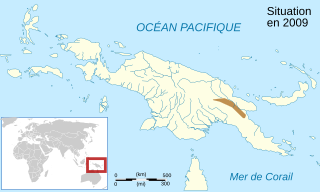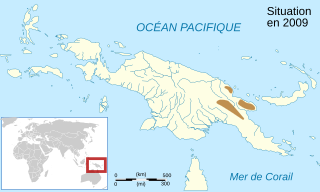Nyctimystes fluviatilis, also known as the Indonesian big-eyed tree frog, is a species of frog in the family Pelodryadidae, also treated as the subfamily Pelodryadinae in the family Hylidae. It is endemic to New Guinea and is known from Idenburg River and Wapoga River in Papua province, Indonesia, and from the Torricelli Mountains in the East Sepik Province and Kavorabip in the Western Province, both in the western Papua New Guinea.
Nyctimystes trachydermis, also known as the Morobe big-eyed treefrog, is a species of frog in the family Pelodryadidae, or alternatively, subfamily Pelodryadinae in the family Hylidae. It is endemic to Papua New Guinea and occurs in the mountains of southern eastern New Guinea. Its type locality is Gapaia Creek, at 1,280 m (4,200 ft) asl between Garaina and Saureli, in the Morobe Province. The specific name trachydermis means "rough skinned", derived from the Greek words trachys and derma.

Aphantophryne minuta is a species of frog in the family Microhylidae. It is endemic to Papua New Guinea and is known from its type locality near Myola Guest House in the Owen Stanley Range, Northern Province, from another locality in the same province, Mount Tafa; only a single specimen is known from each locality. The specific name minuta refers to the very small size of this species. Common name Myola Guinea frog has been coined for it.

Aphantophryne sabini is a species of frog in the family Microhylidae. It is endemic to Papua New Guinea and is only known from the region of its type locality, Myola Guest House in the Owen Stanley Range, Northern Province. The specific name sabini honors Andrew E. Sabin, an American businessman, philanthropist, and environmentalist who joined the expedition during which the holotype of this species was collected. However, its vernacular name Guest House Guinea frog refers to the type locality instead.
Austrochaperina adamantina is a species of frog in the family Microhylidae. It is endemic to New Guinea and occurs in the Torricelli and Bewani Mountains in the West Sepik Province, Papua New Guinea. The specific name adamantina is Latin for "like a diamond" and refers to Jared Diamond, credited as the collector of the holotype and "great many other valuable herpetological specimens from Papua New Guinea".

Austrochaperina aquilonia is a species of frogs in the family Microhylidae. It is endemic to the Sandaun Province, north-western Papua New Guinea. It is only known from two nearby locations in the Torricelli Mountains: Mount Somoro and from the village of Wilbeite. The specific name aquilonia is a Latin adjective meaning "northern" and refers to the range of this species in the north coast mountains of New Guinea.
Austrochaperina basipalmata is a species of frog in the family Microhylidae. It is endemic to the mountain ranges of northern New Guinea and is found between Tawarin River in Papua, Western New Guinea (Indonesia) and Torricelli Mountains in Papua New Guinea.

Copiula derongo is a species of frog in the family Microhylidae. It is endemic to New Guinea and found in both Indonesia and Papua New Guinea. The specific name derongo refers to its type locality, the village of Derongo in the Western Province. Based on molecular evidence, it was transferred from Austrochaperina to Copiula in 2016.

Austrochaperina kosarek is a species of frog in the family Microhylidae. It is endemic to New Guinea and only known from its type locality, Kosarek, in West Papua (Indonesia). It is only known from one specimen collected in 1979. It has not been well-studied but it might be widespread in suitable habitat.

Barygenys cheesmanae is a species of frogs in the family Microhylidae. It is endemic to eastern New Guinea and is only known from Mount Tafa in Central Province, Papua New Guinea. The specific name cheesmanae honors Lucy Evelyn Cheesman, an English entomologist, explorer, curator at London Zoo, and collector of the holotype. Common name Cheesman's Papua frog has been coined for this species.
Barygenys nana is a species of frog in the family Microhylidae. It is endemic to New Guinea and is known from the mountains of Eastern Highlands and Western Highlands Provinces, Papua New Guinea. The specific name nana refers to the small size of this species. Common name highland Papua frog has been proposed for it.

Cophixalus parkeri is a species of frog in the family Microhylidae. It is endemic to Papua New Guinea where it occurs in the central mountainous region between Chimbu and Morobe Provinces. The specific name parkeri presumably honours Hampton Wildman Parker, an English zoologist and herpetologist to whose perusal Arthur Loveridge sent the holotype. Common name Papua rainforest frog has been coined for it.

Cophixalus pipilans is a species of frog in the family Microhylidae. It is endemic to northern mainland Papua New Guinea and occurs between Lae and the Adelbert Mountains. The specific name pipilans is derived from the Latin verb pipilio and means "peeping". Common name Sempi rainforest frog has been coined for this species.

Cophixalus shellyi is a species of frog in the family Microhylidae. It is endemic to Papua New Guinea and occurs in the New Guinea Highlands as well as in the Adelbert Range and on the Huon Peninsula. The specific name shellyi honors Father Otto Schellenberger ("Shelly"), an American missionary and former professor in mathematics who collected the type series.
Oreophryne biroi is a species of frog in the family Microhylidae. It is endemic to New Guinea and occurs on the north coast from Madang Province in Papua New Guinea to the Cyclops Mountains in Papua province, Western New Guinea (Indonesia). The specific name biroi honours Lajos Bíró, a Hungarian zoologist and ethnographer who collected the holotype. Common name New Guinea cross frog has been coined for it.
Oreophryne notata is a species of frog in the family Microhylidae. It is endemic to Papua New Guinea and known from two localities, Ialibu, its type locality in the Southern Highlands Province, and Tabubil in the Western Province. It might occur more widely. The specific name notata is from Latin nota meaning a "mark" or "letter" and refers to the diagnostic U-like pattern on the lores.
Aphantophryne parkeri is a species of frog in the family Microhylidae. It is endemic to the north coast of New Guinea and only known from Matapan and the Bewani Mountains in the West Sepik Province, Papua New Guinea, and from Sentani in the Papua Province, Western New Guinea (Indonesia). This species was formerly included in the genus Oreophryne, but was in 2017 moved to Aphantophryne based on molecular data. The specific name parkeri honours Hampton Wildman Parker, an English zoologist and herpetologist. Common name Parker's cross frog has been coined for it.
Xenorhina zweifeli is a species of frog in the family Microhylidae. It is endemic to New Guinea and is only known from the Bewani and Hunstein Mountains in northern Papua New Guinea. The species is named for American herpetologist Richard G. Zweifel, a specialist in New Guinean herpetology and microhylid frogs; he is also said to share "characteristically terse vocalizations" with this frog.
Xenorhina parkerorum is a species of frog in the family Microhylidae. It is endemic to New Guinea Highlands and occurs in both eastern Western New Guinea (Indonesia) and western Papua New Guinea. Common name Imigabip snouted frog has been proposed for it. The specific name parkerorum honours herpetologists Fred Parker and Hampton Wildman Parker.
Cornufer batantae is a species of frog in the family Ceratobatrachidae. It is endemic to West Papua, Indonesia, and is known from two islands near the New Guinean mainland, Batanta and Waigeo. There are also unconfirmed records from Yapen and Gag Islands. Common name Batanta wrinkled ground frog has been coined for the species.






